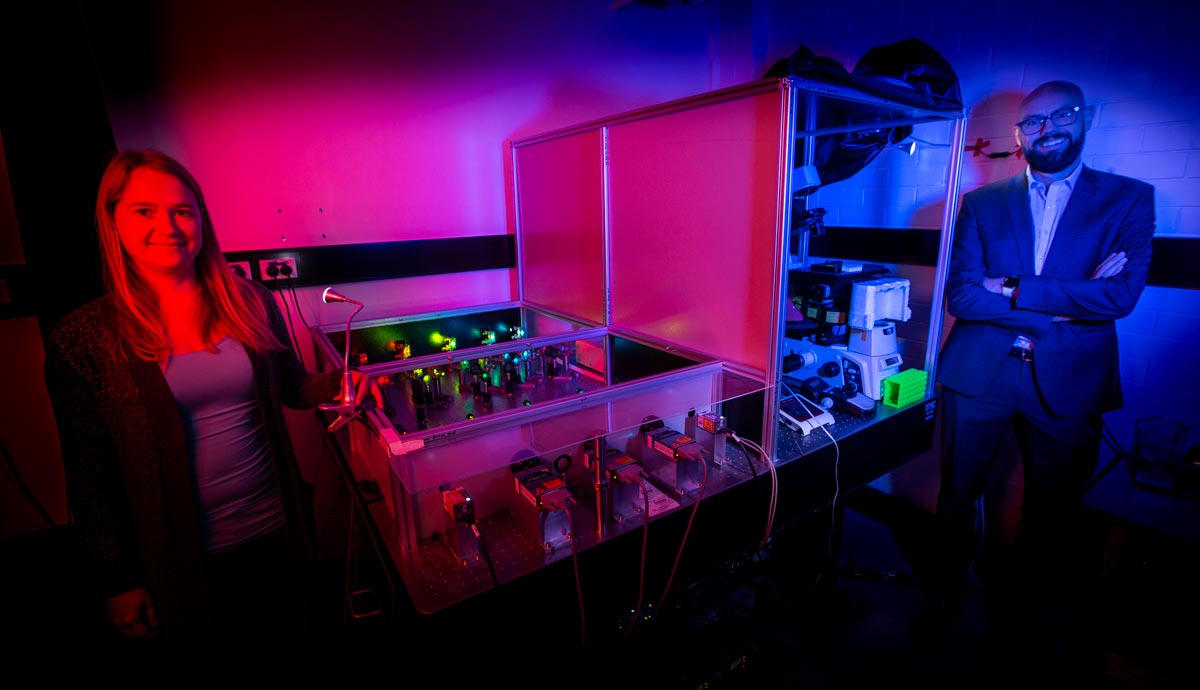April 8, 2019
DNA copying machine a master of resource recycling
Single-molecule visualisation reveals a dynamic, flexible process that adapts to its environment
Researchers at the University of Wollongong’s (UOW) Molecular Horizons initiative have shed new light on how an important but not well understood protein goes about its vital role of reducing errors and mutations in DNA replication.
Single-stranded binding proteins (SSBs) support DNA replication by protecting single-stranded DNA and coordinating, or regulating, the enzymes used to copy the DNA in the correct genetic sequence.
Until recently, it was unclear how SSBs were used in the replisome, the ‘factory’ or molecular complex that copies DNA, with two models suggesting the protein is either available from the cytosol, the aqueous solution in the cell, or the protein is in finite supply and recycled continuously.
The Molecular Horizons work has for the first time revealed the complex molecular choreography where both processes occur. The replisome can adapt how it uses SSBs according to how much is available.
We use microscopes to study how cellular proteins copy DNA.
— Antoine van Oijen 🔬🧫🧬 (@van__Oijen) February 21, 2019
We now show that while copying, the same protein is re-used many times over to coat the DNA.
Like picking up track from behind a train and laying it ahead!@uow @MolHorizons @ihmrihttps://t.co/AdjhJSndHl pic.twitter.com/z4myWXOotr
“DNA replication is elegant but inside the replisome is a cramped and messy place,” lead researcher Dr Lisanne Spenkelink said.
“Until now it hasn’t been shown exactly how SSBs are used. What we have revealed is a dynamic and highly efficient process that adapts to its surrounding conditions.”
When a cell divides, it produces two ‘daughter’ cells that must contain the same genetic parent information to be able to carry out its required function. This information comes from replicating the parent cell’s DNA and transmitting it to the new cell.
As the double-helix DNA unwinds into two strands, one strand, called the leading strand, is copied and formed into a new double helix almost as soon as it’s unzipped.
The other strand, called the lagging strand, is momentarily exposed because the processes of unzipping the helix and copying the genetic information run in opposite directions.
As a result, the strand has fragments of copied DNA and gaps in other sections. The exposed strand faces two threats. Firstly, it could be attacked by proteins whose job it is to destroy viruses with single-stranded DNA as their genetic material.
Here, SSB’s job is to coat the lagging strand and protect it from being attacked and broken. A broken strand can cause chromosome breakage, which can contribute to genetic disorders and intergenerational disease.
Addressing the second threat, SSBs also help coordinate DNA copying and avoiding mistakes that could lead to mutations by regulating which enzyme is used to prepare the strand for copying. Yet, errors can occur.
The wrong enzyme means the DNA sequence – the series of letters or base pairs that form a genetic code – could be mismatched, resulting in a mutated DNA sequence.
Though errors are rare, occurring at a rate of 1 mistake per million base pairs, one mistake that slips past the repair mechanisms can produce a DNA sequence that, if it survives and avoids the body’s defence mechanisms, could also survive drug treatments and eventually become a superbug.
As a result, understanding SSBs’ role is crucial in understanding disease and antimicrobial resistance.
Previous studies have used short strands of DNA and SSBs in isolation. While this has provided general insights into the interaction between the two, they have not shown how SSBs work in the context of the complete DNA replication process inside the replisome.
Molecular Horizons researchers extracted an active replisome from E. Coli bacteria to visualise at single-molecule resolution SSB behaviour as DNA replication happens.
“If you think of the replisome as a car, it’s a complete functional system, but we can’t really test the more intricate parts of the engine,” Dr Spenkelink said.
“To do that, engineers might remove the engine and bench test it. That allows them a more detailed look at specific parts that can’t be tested in a moving car.
“We’ve done a similar thing with replisome. We’ve taken out a single DNA molecule and with high-resolution imaging, we can gather genetic information and visualise processes that would otherwise be hidden.”
The results, published recently in the journal Nucleic Acids Research, challenge the notion that DNA replication is uniform and consistent, as well as providing for the first time single-molecule-level detail of how SSB works during replication.
“We’re seeing the reality of replisome plasticity,” said Molecular Horizons Director Professor Antoine van Oijen. “If it’s starved of resources, it hangs on to SSBs for dear life by recycling them.
“If there’s an abundance of SSBs, they’re easily absorbed into cell cytosol after replication. The replisome can easily transition between the two states based on the concentration of SSB.”
The next stage of the research is to see if similar behaviour occurs in yeast, which is more biologically complex than E. coli, but because it has a cell nucleus, has more in common with human cells, providing vital clues about the molecular mechanisms driving the formation of antimicrobial resistance and superbugs.
“With increasingly sophisticated imaging techniques and novel methods, we can see these attempts to reconnect broken strands, how errors are copied and how mutations occur, all of which are potential factors in antimicrobial resistance,” Professor van Oijen said.
“At Molecular Horizons we’re trying to understand the mechanisms by visualising the structures and pathways in a single molecule that lead to disease.
“Once we know the pieces of the puzzle, we can design drugs that are very specific in how they interact with molecules to overcome antimicrobial resistance and potentially avoid chronic diseases.”
